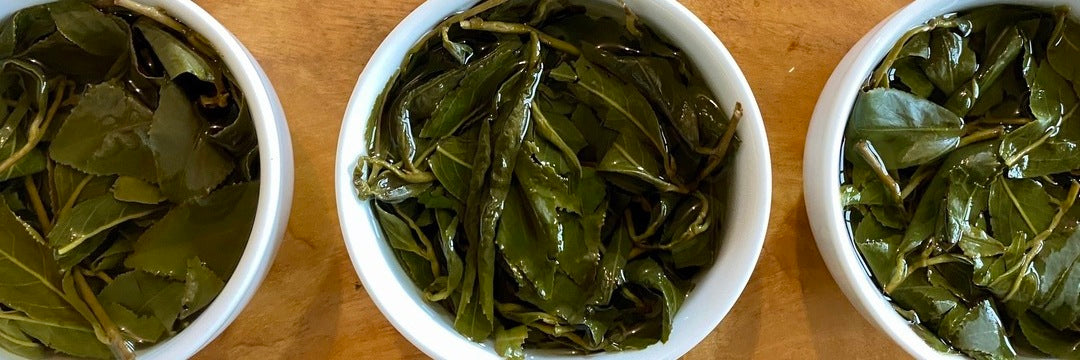
Spring 2024 High Mountain Oolong Teas

Our spring 2024 high mountain Taiwan Oolong teas are all in, and we brewed them side by side to see how they compare with each other. We brewed them in the "factory cupping style" — 6g of tea leaves in a standard tea judging bowl, filled with boiling temp water, and sipped as they brew. The real results are when the tea has cooled considerably, and the brewed tea has become somewhat concentrated. This method allows us to visually assess the brewed tea leaves as well. On the left is our Alishan High Mountain Oolong Tea. In the middle is our Shan Lin Xi High Mountain Oolong Tea. And on the right is our Li Shan High Mountain Oolong Tea.

Alishan is the southernmost high mountain tea growing region, and is the first of the three spring harvests. It also has the warmest and sunniest climate, which gives Alishan its distinctive character. It is known for its buttery sweet, softer and more accessible flavor profile — which has made it the most well known name for Taiwan's world famous High Mountain Oolong Tea. Our spring batch of Alishan is relatively mature leaf material that has been significantly oxidized. This offers a sweet, pastry flavor profile with aromatic notes of warming spices like nutmeg and cardamom.

Heading north, Shan Lin Xi is a more forested mountainous region with narrow valleys that get daily afternoon fog. This moist, cooler climate gives Shan Lin Xi its fir forest, savory character that has made it a favorite among veteran high mountain tea lovers. Our spring batch offers this classic Shan Lin Xi profile of savory herbs and fresh alpine forest aroma. The leaves are young but substantial, and sufficiently oxidized — giving it a full-flavored, balanced composition.

Li Shan is much further north than both Alishan and Shan Lin Xi, and is also considerably higher in elevation. It's closer to a temperate climate, and has a much bigger diurnal temperature range — with strong sun by day and very cool temps by night. This climate produces a significantly more substantial constitution of leaf material. This spring's batch was picked while still very young, and was lightly yet uniformly oxidized. These leaves brew up an exceedingly smooth, substantial brew with fresh fruity and floral notes. Check our our blogpost and video of our Li Shan spring 2024 sourcing trip!
In sum, these three batches of spring high mountain tea turned out to be sequentially in order in terms of their maturity of the leaves and their degree of oxidation. Alishan is more mature leaves with the most significant oxidation — offering a sweet, pastry profile with a satisfying finish. Shan Lin Xi has a fresh savory character with a foresty aromatic profile. Li Shan has an amazing silky smooth texture with fresh floral notes.
We like them all for their distinctive attributes, and enjoy reaching for them on a given day, depending on what we feel like. This is the beauty of experiencing the seasonal offerings of Taiwan's High Mountain Oolongs. They offer subtle variations from season to season, while maintaining their fundamental regional personalities. Join us in our endless explorations through the seasons, year after year, from region to region!
LET US KNOW!
Please post any questions or comments you may have in the comments section below!
SUBSCRIBE!
If you enjoyed this post and would like to hear more about the specialty tea industry here in Taiwan, follow us on YouTube, Facebook, and Instagram and please subscribe to our newsletter. Subscribe now and get US$5 off your first order.

